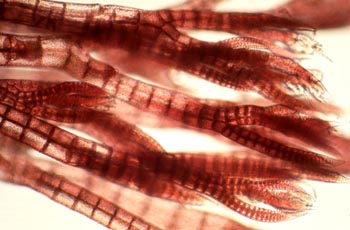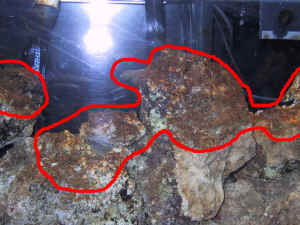

There are approximately 1100 species of fire algae. These are single celled algae and include dinoflagellates which have two flagella for locomotion. They live in salt as well as fresh water. They have cell walls made of cellulose. They store energy as starch. Dinoflagellates emit bright flashes of light when exposed to air which at night look like fire on an ocean's surface.

(4) GREEN ALGAE (CHLOROPHYTA):
There are approximately 7000 species of green algae. They are either single celled and microscopic forming the green scum found in stagnant ponds. Others are larger composed of many cells forming spherical colonies. These occur in fresh as well as sea water. The cell walls of green algae are mostly constructed of cellulose and calcium carbonate. The food reserves of green algae are starch and their cells have flagella which are used in a whip like fashion for locomotion.

(5) RED ALGAE (RHODOPHYTA):
There are 4000 species of red algae. These are marine plants that live in shallow waters and deep tropical seas. A few occur in fresh water. They have no flagella. Their cell walls are constructed of cellulose and polysacchrides. They store energy as specialized polysacchride known as floridean starch.

(6) BROWN ALGAE (PAEOPHYTA):
There are 1500 species of brown algae almost all of which occur in marine environments. They have cell walls made of cellulose and polysacchrides known as alginic acids. They have two flagella for locomotion. The food reserves of these algae are carbohydrate polymers.

(7) YELLOW GREEN ALGAE (XANTHOPHYTA):
There are approximately 450 species that occur in fresh water. They can be either single celled or form colonies. Their cell walls are made of cellulose and pectic compounds. The food reserves of these algae are carbohydrates. They have two or more flagella for locomotion. They derive their yellow green colour from the carotenoids and xanthophyll.






No response to “ALGAE”
Post a Comment